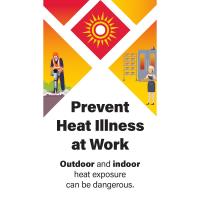The Heat Stress Standards under COMAR 09.12.32 are minimum requirements for employers to protect employees from heat-related illnesses caused by heat stress in the workplace. This applies to employers with employees whose employment activities, indoor or outdoor, expose employees to a heat index in the area where the employee is working that equals or exceeds 80 degrees Fahrenheit.
Proposed regulations have hit the Maryland Register and there is a 30-day public comment period which is open now and closes on August 26th. Comments should be submitted to: dli.regullations+heat@maryland.gov
A virtual public hearing will be held on August 16 at 1:00PM A link will become available on MDDOL’s website: https://www.labor.maryland.gov/labor/mosh/
Overview: Heat Stress Standards COMAR 09.12.32
The Heat Stress Standards under COMAR 09.12.32 are minimum requirements for employers to protect employees from heat-related illnesses caused by heat stress in the workplace. This applies to employers with employees whose employment activities, indoor or outdoor, expose employees to a heat index in the area where the employee is working that equals or exceeds 80 degrees Fahrenheit. The Heat Stress Standards address the required Prevention and Management Plan, Acclimatization Standards, Shade Access Standards, Drinking Water Standards, High Heat Procedures, Emergency Response, and Training. These standards do not apply to emergency operations and essential services as defined in Regulation .03B(4); incidental exposures (less than 15 consecutive minutes); or buildings that have ventilation systems that maintain heat index below 80 degrees.
Employers are required to create a Heat Illnesses Prevention and Management Plan, and to monitor the heat index throughout the work shift in areas where employees perform work. Employers must develop, implement and maintain an effective illness prevention and management plan in writing and must be available and accessible to employees and MOSH upon request.
Employers are required to provide for acclimatization of exposed employees for a period of up to 14 days for those newly exposed and returning to work after 7 or more consecutive days of absence from the workplace. Employers are required to monitor employees during the acclimatization period through regular communication. Employers are required to develop and implement an acclimatization plan in compliance with daily gradual increase in exposure time specified or with OSHA recommendations for acclimatization.
Employers are required to provide shade access to exposed employees, and if creating outdoor shade is infeasible, employers must implement alternative cooling and control measures.
Employers are required to provide at least 32 ounces of drinking water per hour per employee at no cost, available at the beginning of an employee's shift and all times while work is being performed.
Employers shall implement high heat procedures when the heat index reaches or exceeds 90 degrees Fahrenheit in the work area. High heat procedures must include work and rest schedules adjusted for environmental conditions, workload etc. that comply with minimum rest periods. If an employer can demonstrate effective heat management and protection (.08.E) from illness through cooling and control measures, work and rest schedules under section C may not be required.
The standards require employers to implement an emergency response plan and detail the required procedures.
Employers are required to provide initial heat stress training prior to an employee’s first exposure to heat. Re-trainings are required annually and immediately following a suspected or confirmed heat related illness. Employers are required to keep training records.

